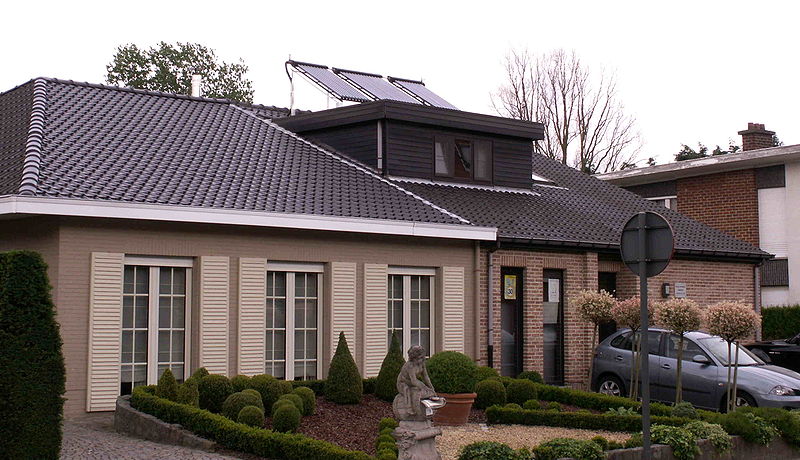An estimated one million residential and 200,000 commercial solar water-heating systems have been installed in the United States. Although there are a large number of different types of solar water-heating systems, the basic technology is very simple.
Sunlight strikes and heats an "absorber" surface within a "solar collector" or an actual storage tank. These roof-mounted solar heaters supply about 80% of the hot water for the home. Either a heat-transfer fluid or the actual potable water to be used flows through tubes attached to the absorber and picks up the heat from it. (Systems with a separate heat-transfer-fluid loop include a heat exchanger that then heats the potable water.) The heated water is stored in a separate preheat tank or a conventional water heater tank until needed.
If additional heat is needed, it is provided by electricity or fossil-fuel energy by the conventional water-heating system.

How a Solar Water Heater Works
Click the “play” button to see how a solar water heater operates.
Cold water is pumped to the solar collector on the roof of the house, where it is warmed by sunlight. The warm water then travels down into a storage tank and then to a conventional water heater. The water is heated further and becomes hot and available for use.
By reducing the amount of heat that must be provided by conventional water heating, solar water-heating systems directly substitute renewable energy for conventional energy, reducing the use of electricity or fossil fuels by as much as 80%.
Today's solar water-heating systems are proven reliable when correctly matched to climate and load. The current market consists of a relatively small number of manufacturers and installers that provide reliable equipment and quality system design.
A quality assurance and performance-rating program for solar water-heating systems, instituted by a voluntary association of the solar industry and various consumer groups, makes it easier to select reliable equipment with confidence.
Building owners should investigate installing solar hot water-heating systems to reduce energy use. However, before sizing a solar system, water-use reduction strategies should be put into practice.
Types of Solar Hot Water Heaters
There are five types of solar hot water systems:
- Thermosiphon Systems. These systems heat water or an antifreeze fluid, such as glycol. The fluid rises by natural convection from collectors to the storage tank, which is placed at a higher level. No pumps are required. In thermosiphon systems, fluid movement, and therefore heat transfer, increases with temperature, so these systems are most efficient in areas with high levels of solar radiation.
- Direct-Circulation Systems. These systems pump water from storage to collectors during sunny hours. Freeze protection is obtained by recirculating hot water from the storage tank, or by flushing the collectors (drain-down). Since the recirculation system increases energy use, while flushing reduces the hours of operation, direct-circulation systems are used only in areas where freezing temperatures are infrequent.
- Drain-Down Systems. These systems are generally indirect water-heating systems. Treated or untreated water is circulated through a closed loop, and heat is transferred to potable water through a heat exchanger. When no solar heat is available, the collector fluid is drained by gravity to avoid freezing and convection loops, in which cool collector water reduces the temperature of the stored water.
- Indirect Water-Heating Systems. In these systems, freeze-protected fluid is circulated through a closed loop and its heat is transferred to potable water through a heat exchanger with 80 to 90 percent efficiency. The most commonly used fluids for freeze protection are water-ethylene glycol solutions and water-propylene glycol solutions.
- Air Systems. In this indirect system, the collectors heat the air, which is moved by a fan through an air-to-water heat exchanger. The water is then used for domestic or service needs. The efficiency of the heat exchanger is in the 50% range.
Direct-circulation, thermosiphon, or pump-activated systems require higher maintenance in freezing climates. For most of the United States, indirect air and water systems are the most appropriate. Air solar systems, while not as efficient as water systems, should be considered if maintenance is a primary concern since they do not leak or burst.